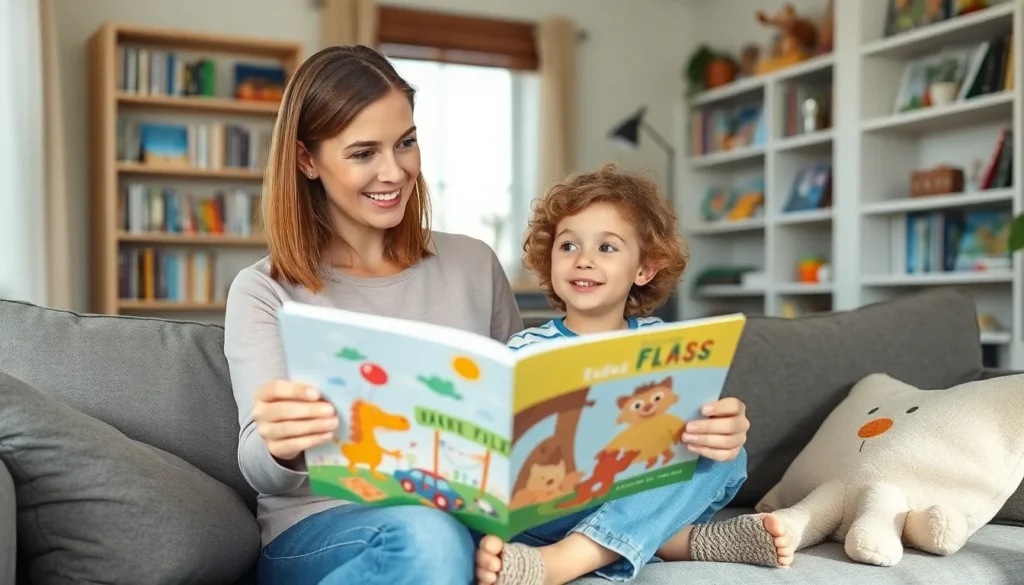In a world filled with digital distractions, fostering a love for reading in children has never been more important. Parents play a crucial role in guiding their young readers, helping them navigate the vast array of books available today. A well-crafted reading guide can empower parents to make informed choices, ensuring their children engage with stories that spark curiosity and imagination.
This parent reading guide offers valuable insights into selecting age-appropriate books, understanding different genres, and encouraging discussions that enhance comprehension. By equipping themselves with the right tools, parents can create a nurturing environment where reading becomes a cherished activity, paving the way for lifelong learning and exploration.
Table of Contents
ToggleUnderstanding Parent Reading Guides
Parent reading guides serve as essential tools that support and enhance children’s reading experiences. These guides help parents navigate book choices and foster meaningful interactions between children and literature.
Importance of Reading Guides
Reading guides provide structured support in the selection of books suited to children’s interests and developmental stages. They outline critical themes, suggest age-appropriate content, and highlight diverse genres. By utilizing reading guides, parents can make informed choices that align with their child’s reading level, fostering a positive reading environment. Specifically, reading guides enable parents to introduce new authors and series that expand children’s literary exposure.
Benefits for Parents and Children
Reading guides offer multiple advantages for both parents and children.
- Enhanced Engagement: Reading guides promote active discussions and engagement surrounding books. Parents can ask open-ended questions, increasing children’s comprehension and critical thinking.
- Skill Development: Guides provide strategies for parents to support reading skills. Techniques such as summarizing and predicting allow children to practice analytical skills.
- Confidence Building: Children exposed to carefully selected reading material gain confidence in their abilities and are more likely to explore new books independently.
- Strengthened Bonds: Shared reading experiences lead to stronger parent-child relationships. Parents and children connect through conversations about characters and storylines, making reading a bonding activity.
By leveraging parent reading guides, families can enrich their reading experiences, encouraging a deeper appreciation for literature and continuous learning.
Selecting the Right Reading Guide

Choosing the correct reading guide enhances children’s reading experiences and fosters a genuine love for literature. Parents can efficiently navigate book selections by focusing on specific criteria.
Age Appropriateness
Selecting age-appropriate books is essential for maintaining children’s interest and comprehension. Guides typically categorize literature by developmental stages:
- Infants and Toddlers: Board books with simple images and rhythmic text promote sensory engagement.
- Preschoolers: Picture books offer rich illustrations and straightforward narratives, aiding vocabulary expansion.
- Early Elementary: Early chapter books introduce characters and plots that build reading confidence.
- Middle Grade: Novels with more complex themes help develop critical thinking and empathy.
- Young Adult: Stories tackle mature subjects, encouraging deeper discussions and personal reflection.
Identifying an appropriate reading level ensures materials challenge yet engage young readers, preventing frustration or disinterest.
Genre Considerations
Exploring various genres exposes children to diverse styles and thematic elements. Guides often encompass multiple genres for a well-rounded reading experience, including:
- Fiction: Captivating stories stimulate imagination and creativity.
- Non-Fiction: Informative texts promote knowledge acquisition on various subjects.
- Fantasy: Imaginative worlds foster creativity and wonder.
- Historical Fiction: Narrative contexts enhance understanding of history and empathy for different cultures.
- Mystery: Problem-solving plots encourage analytical thinking.
Selecting a mixture of genres helps children discover their preferences, enhancing their engagement and motivation to read.
How to Use a Parent Reading Guide Effectively
A parent reading guide enhances the reading experience by providing structured support and strategies. Utilizing it effectively involves setting clear goals and fostering interactive discussions.
Setting Reading Goals
Setting specific reading goals helps in guiding children’s literary journeys. Goals can range from completing a certain number of books each month to exploring specific genres or themes. For example, a goal might be to read five books from the mystery genre within two months. Parents can track progress and celebrate achievements, reinforcing positive reading behaviors. Adjusting goals based on children’s interests and evolving skills also maintains engagement and motivation.
Encouraging Discussion and Interaction
Encouraging open discussions about books promotes deeper understanding and critical thinking. Parents should ask open-ended questions that stimulate conversation, such as “What did you like most about this character?” or “How would you change the ending?” By incorporating interactive elements like summarizing plot points or predicting future events, parents foster analytical skills in young readers. Sharing personal reflections on the material also strengthens connections and enriches the reading experience, creating a shared love for literature.
Recommended Parent Reading Guides
Parent reading guides offer structured recommendations that help cultivate a love for literature among children and teens. Below are curated selections tailored for different age groups.
Top Picks for Young Readers
- “The Pigeon Finds a Hot Dog!” by Mo Willems
Engaging illustrations and simple text make this book ideal for preschoolers. Humor and relatable characters encourage interaction.
- “Where the Wild Things Are” by Maurice Sendak
This classic captures imagination with its themes of adventure and emotions. Its vibrant artwork captivates young minds.
- “Pete the Cat: I Love My White Shoes” by Eric Litwin
This fun, musical story promotes resilience and positivity through catchy rhythms. Interactive reading practices enhance engagement.
- “The Very Hungry Caterpillar” by Eric Carle
With its unique illustrations and educational content, this book teaches counting and days of the week. It’s perfect for early learners.
- “Goodnight Moon” by Margaret Wise Brown
The soothing text and repetitive structure make bedtime reading enjoyable. It fosters comfort and familiarity for young children.
Suggestions for Teens
- “The Hunger Games” by Suzanne Collins
This dystopian novel captivates with suspense and strong character development. It invites discussions on society and morality.
- “The Fault in Our Stars” by John Green
Emotional depth and relatable themes resonate with teens. Discussions about life and love can enhance empathy and understanding.
- “To Kill a Mockingbird” by Harper Lee
This literary classic explores complex themes of justice and morality. It fosters critical discussions about social issues.
- “The Hate U Give” by Angie Thomas
Timely and relevant, this novel addresses race and identity. It prompts discussions on current events and personal experiences.
- “Eleanor & Park” by Rainbow Rowell
This poignant story about first love offers rich themes of acceptance and belonging. Engaging conversations about relationships may emerge.
Fostering a love for reading in children is a rewarding journey that parents can embark on together with their young readers. Utilizing a well-crafted parent reading guide not only simplifies the process of selecting age-appropriate books but also enhances the overall reading experience. Through structured support and engaging discussions, parents can help their children develop critical thinking skills and build confidence in their reading abilities.
By exploring various genres and setting clear reading goals, families can cultivate a deeper appreciation for literature. The recommended titles serve as a springboard for meaningful literary exploration. Embracing these resources transforms reading into a shared adventure that strengthens the bond between parents and children, paving the way for a lifelong love of books.








